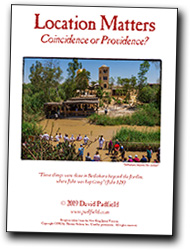Location Matters
It has been claimed that British real estate tycoon Lord Harold Samuel coined the expression: "There are three things that matter in property: location, location, location." Today that phrase is still the real estate agents' mantra: location, location, location.

When studying the Bible, you should always keep the location of Bible events in mind. The Bible does not contain any filler material—every word in Scripture is there for a reason. As you study the gospels and find a city mentioned by name, you should always stop and ask yourself, "What happened here before?" For example, even the most casual of Bible students know that Jesus was born in Bethlehem of Judea (Luke 2:4–6; Matt 2:1–6). As Luke has already explained, Bethlehem was the ancestral home of David, Israel's most beloved king (Luke 2:4). Thus, it is fitting that the one who would sit on "David's throne" would be tied to that great king by ancestry and a shared hometown (Micah 5:2).
Location Matters is a new sermon book by David Padfield that examines several New Testament stories and shows how the location of the event has a great deal of bearing on our understanding of the story. The first sermon deals with why John the Baptist was baptizing "Bethabara beyond the Jordan" (John 1:28), then why Jesus began His ministry at Capernaum," in the regions of Zebulun and Naphtali" (Matt 4:13). The lesson ends with Jesus raising a young man back to life at Nain (Luke 7:11–15), in the same area where Elisha had restored a child to life (2 Kings 4:8, 18–37).
The second lesson begins at Caesarea Philippi, where Jesus asked His disciples a serious question concerning His identity (Matt 16:13–20). The last two cities noted in this lesson are places where Paul had visited during his missionary journeys. The first city examined is Antioch of Pisidia, where Paul and Barnabas were mistaken for two Greek gods (Zeus and Hermes). The lesson ends with the story behind the "Unknown God" Paul spoke of at Athens (Acts 17:23).
This is a free book you can download and print out for your classes (13 pages; PDF file size: 997k).
All of the books on this website may be reprinted by individuals, churches, schools, and seminaries for use in their teaching program. However, these class books may not be altered in any way, and they must be given away at no charge.
